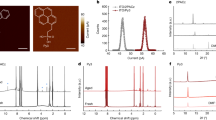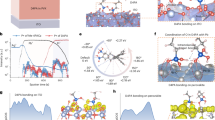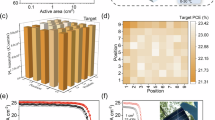Abstract
Conjugated polymers of diketopyrrolopyrrole (DPP) and thiophene, especially 2,5-di-2-thienyl-thieno[3,2-b]thiophene, were characterized based on their molecular packing orientation, and they showed a π–π stacking distance of 3.6 Å and a high field-effect hole mobility on the order of 10−2 cm2/Vs. Perovskite solar cells fabricated with the genuine or both oxidant- and salt dopant-free polymer as the hole-transporting layer displayed high photoconversion efficiencies of 16.3% as well as high durability.
Similar content being viewed by others
Log in or create a free account to read this content
Gain free access to this article, as well as selected content from this journal and more on nature.com
or
References
Guo X, Baumgarten M, Müllen K. Designing π-conjugated polymers for organic electronics. Prog Polym Sci. 2013;38:1832–908.
Rivnay J, Mannsfeld SCB, Miller CE, Salleo A, Toney MF. Quantitative determination of organic semiconductor microstructure from the molecular to device scale. Chem Rev. 2012;112:5488–519.
Jikei M, Mori R, Kawauchi S, Kakimoto M, Taniguchi Y. Synthesis and properties of hyperbranched poly(triphenylamine)s prepared by palladium catalyzed C–N coupling reaction. Polym J. 2002;34:550–7.
Davis AR, Maegerlein JA, Carter KR. Electroluminescent networks via photo “click” chemistry. J Am Chem Soc. 2011;133:20546–51.
Michinobu T. Click functionalization of aromatic polymers for organic electronic device applications. Macromol Chem Phys. 2015;216:1387–95.
Saito M, Osaka I. Impact of side chain placement on thermal stability of solar cells in thiophene–thiazolothiazole polymers. J Mater Chem C. 2018. https://doi.org/10.1039/C7TC04721E.
Fukuta S, Higashihara T. Ternalization approach for tuning light absorption and crystalline structure of diketopyrrolopyrrole-based polymer using bisthiadiazole unit. J Electrochem Soc. 2018;165:B3001–5.
Zhou E, Yamakawa S, Tajima K, Yang C, Hashimoto K. Synthesis and photovoltaic properties of diketopyrrolopyrrole-based donor−acceptor copolymers. Chem Mater. 2009;21:4055–61.
Kaur M, Choi DH. Diketopyrrolopyrrole: brilliant red pigment dye-based fluorescent probes and their applications. Chem Soc Rev. 2015;44:58–77.
Liu F, Wang C, Baral JK, Zhang L, Watkins JJ, Briseno AL, et al. Relating chemical structure to device performance via morphology control in diketopyrrolopyrrole-based low band gap polymers. J Am Chem Soc. 2013;135:19248–59.
Yang L, Yu Y, Gong Y, Li J, Ge F, Jiang L, et al. Systematic investigation of the synthesis and light-absorption broadening of a novel diketopyrrolopyrrole conjugated polymer of low and high molecular weight with thermo-labile groups. Polym Chem. 2015;6:7005–14.
Kuwabara J, Takase N, Yasuda T, Kanbara T. Synthesis of conjugated polymers possessing diketopyrrolopyrrole units bearing phenyl, pyridyl, and thiazolyl groups by direct arylation polycondensation: effects of aromatic groups in DPP on physical properties. J Polym Sci Part A Polym Chem. 2016;54:2337–45.
Kuwabara J, Yamagata T, Kanbara T. Solid-state structure and optical properties of highly fluorescent diketopyrrolopyrrole derivatives synthesized by cross-coupling reaction. Tetrahedron Lett. 2010;66:3736–41.
Cho M, Shin J, Hong T, Um H, Lee TW, Kim G, et al. Diketopyrrolopyrrole-based copolymers bearing highly π-extended donating units and their thin- film transistors and photovoltaic cells. Polym Chem. 2015;6:150–9.
Cho M, Shin J, Yoon SH, Lee TW, Kaur M, Choi DH. A high-mobility terselenophene and diketopyrrolopyrrole containing copolymer in solution-processed thin film transistors. Chem Commun. 2013;49:7132–4.
Bronstein H, Chen Z, Ashraf RS, Zhang W, Du J, Durrant JR, et al. Thieno[3,2-b]thiophene-diketopyrrolopyrrole-containing polymers for high-performance organic field-effect transistors and organic photovoltaic devices. J Am Chem Soc. 2011;133:3272–5.
Yao J, Yu C, Liu Z, Luo H, Yang Y, Zhang G, et al. Significant improvement of semiconducting performance of the diketopyrrolopyrrole–quaterthiophene conjugated polymer through side-chain engineering via hydrogen-bonding. J Am Chem Soc. 2016;138:173–85.
Kim G, Kang S, Dutta GK, Han Y, Shin TJ, Noh Y, et al. Thienoisoindigo-naphthalene polymer with ultrahigh mobility of 14.4 cm2/V·s that substantially exceeds benchmark values for amorphous silicon semiconductors. J Am Chem Soc. 2014;136:9477–83.
Lee JS, Son SK, Song S, Kim H, Lee DR, Kim K, et al. Importance of solubilizing group and backbone planarity in low band gap polymers for high performance ambipolar field-effect transistors. Chem Mater. 2012;24:1316–23.
Ha JS, Kim KH, Choi DH. 2,5-Bis(2-octyldodecyl)pyrrolo[3,4-c]pyrrole-1,4-(2H,5H)-dione-based donor–acceptor alternating copolymer bearing 5,5′-di(thiophen-2-yl)-2,2′-biselenophene exhibiting 1.5 cm2·V-1·s-1 hole mobility in thin-film transistors. J Am Chem Soc. 2011;133:10364–7.
Li Y, Sonar P, Singh SP, Soh MS, Meurs M, Tan J. Annealing-free high-mobility diketopyrrolopyrrole-quaterthiophene copolymer for solution-processed organic thin film transistors. J Am Chem Soc. 2011;133:2198–204.
Li Y, Sun B, Sonar P, Singh SP. Solution processable poly(2,5-dialkyl-2,5-dihydro-3,6-di-2-thienyl- pyrrolo[3,4-c]pyrrole-1,4-dione) for ambipolar organic thin film transistors. Org Electron. 2012;13:1606–13.
Dou L, Gao J, Richard E, You j, Chen C, Cha KC, et al. Systematic investigation of benzodithiophene- and diketopyrrolopyrrole-based low-bandgap polymers designed for single junction and tandem polymer solar cells. J Am Chem Soc. 2012;134:10071–9.
Walker B, Tamayo AB, Dang X, Zalar P, Seo H, Garcia A, et al. Nanoscale phase separation and high photovoltaic efficiency in solution-processed, small-molecule bulk heterojunction solar cells. Adv Funct Mater. 2009;19:3063–9.
Choi M, Ko EJ, Han YW, Lee EJ, Moon DK. Control of polymer-packing orientation in thin films through chemical structure of D-A type polymers and its application in efficient photovoltaic devices. Polym (Guildf). 2005;74:205–15.
Suwa K, Tanaka S, Oyaizu K, Nishide H. Arylamine polymers prepared via facile paraldehyde-addition condensation: an effective hole-transporting material for perovskite solar Cells. Polym Int. 2018;67:670–4.
Zhang F, Wang Z, Zhu H, Pellet N, Luo J, Yi C, et al. Over 20% PCE perovskite solar cells with superior stability achieved by novel and low-cost hole-transporting materials. Nano Energy. 2017;41:469–75.
Kinoshita T, Nonomura K, Jeon NJ, Giordano F, Abate A, Uchida S, et al. Spectral splitting photovoltaics using perovskite and wideband dye-sensitized solar cells. Nat Commun. 2015;6:8834–41.
Ahn N, Son D, Jang I, Kang S, Choi M, Park N. Highly reproducible perovskite solar cells with average efficiency of 18.3% and best efficiency of 19.7% fabricated via lewis base adduct of lead(II) iodide. J Am Chem Soc. 2015;137:8696–9.
Kojima A, Teshima K, Shirai Y, Miyasaka T. Organometal halide perovskites as visible-light sensitizers for photovoltaic cells. J Am Chem Soc. 2009;131:6050–1.
Cojocaru L, Uchida S, Sanehira Y, Nakazaki J, Kubo T, Segawa H. Surface treatment of the compact TiO2 layer for efficient planar heterojunction perovskite solar cells. Chem Lett. 2015;44:674–6.
Zhao Y, Tan H, Yuan H, Yang H, Fan JZ, Kim J, et al. Perovskite seeding growth of formamidinium-lead- iodide-based perovskites for efficient and stable solar cells. Nat Commun. https://doi.org/10.1038/s41467-018-04029-7.
Yang WS, Noh JH, Jeon NJ, Kim YC, Ryu S, Seo J, et al. High-performance photovoltaic perovskite layers fabricated through intramolecular exchange. Science. 2015;348:1234–7.
Yang WS, Park BW, Jung EH, Jeon NJ, Kim YC, Lee DU, et al. Iodide management in formamidinium-lead-halide–based perovskite layers for efficient solar cells. Science. 2017;356:1376–9.
Ameen S, Rub MA, Kosa SA, Alamry KA, Akhtar MS, Shin HS, et al. Perovskite solar cells: influence of hole transporting materials on power conversion efficiency. ChemSusChem. 2016;9:10–27.
Heo JH, Han HJ, Kim D, Ahn TK, Im SH. Hysteresis-less inverted CH3NH3PbI3 planar perovskite hybrid solar cells with 18.1% power conversion efficiency. Energy Environ Sci. 2015;8:1602–8.
Kwon YS, Lim J, Yun HJ, Kim YH, Park T. A diketopyrrolopyrrole-containing hole transporting conjugated polymer for use in efficient stable organic–inorganic hybrid solar cells based on a perovskite. Energy Environ Sci. 2014;7:1454–60.
Dubey A, Adhikari N, Venkatesan S, Gu S, Khatiwada D, Wang Q, et al. Solution processed pristine PDPP3T polymer as hole transport layer for efficient perovskite solar cells with slower degradation. Sol Energy Mater Sol Cells. 2016;145:193–9.
Zhang Y, Grancini G, Feng Y, Asiri AM, Nazeeruddin MK. Optimization of stable quasi-cubic FAxMA1−xPbI3 perovskite structure for solar cells with efficiency beyond 20%. ACS Energy Lett. 2017;2:802–6.
Saliba M, Matsui T, Seo JY, Domanski K, Correa-Baena JP, Nazeeruddin MK, et al. Cesium-containing triple cation perovskite solar cells: improved stability, reproducibility and high efficiency. Energy Environ Sci. 2016;9:1989–97.
Saliba M, Matsui T, Domanski K, Seo JY, Ummadisingu A, Zakeeruddin SM, et al. Incorporation of rubidium cations into perovskite solar cells improves photovoltaic performance. Science. 2016;354:206–9.
Acknowledgements
This work was partially supported by “Research and Development of Innovative Nano Structure Solar Cells” from NEDO, Japan. HM and KS acknowledge the Leading Graduate Program in Science and Engineering, Waseda University from MEXT, Japan.
Author information
Authors and Affiliations
Corresponding author
Ethics declarations
Conflict of interest
The authors declare that they have no conflict of interest.
Electronic supplementary material
Rights and permissions
About this article
Cite this article
Maruo, H., Sasaki, Y., Harada, K. et al. Hole-transporting diketopyrrolopyrrole-thiophene polymers and their additive-free application for a perovskite-type solar cell with an efficiency of 16.3%. Polym J 51, 91–96 (2019). https://doi.org/10.1038/s41428-018-0116-9
Received:
Revised:
Accepted:
Published:
Issue date:
DOI: https://doi.org/10.1038/s41428-018-0116-9



